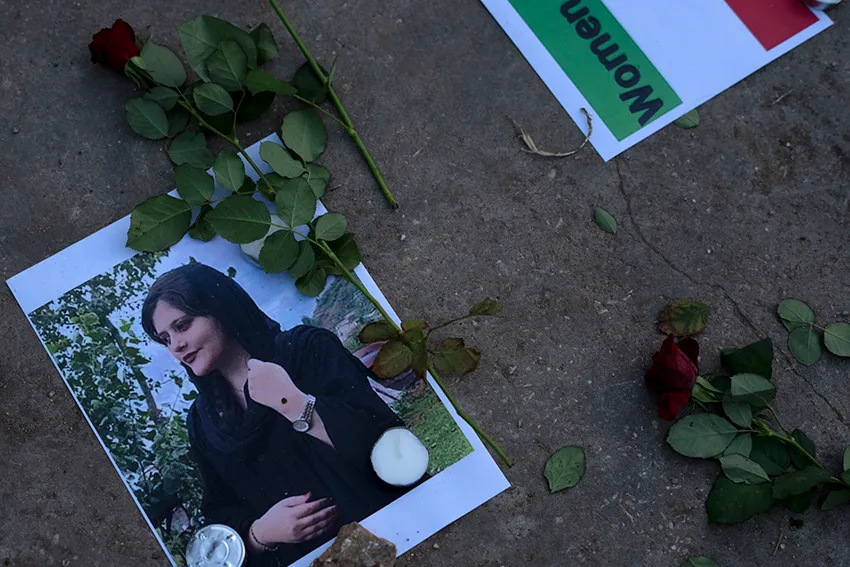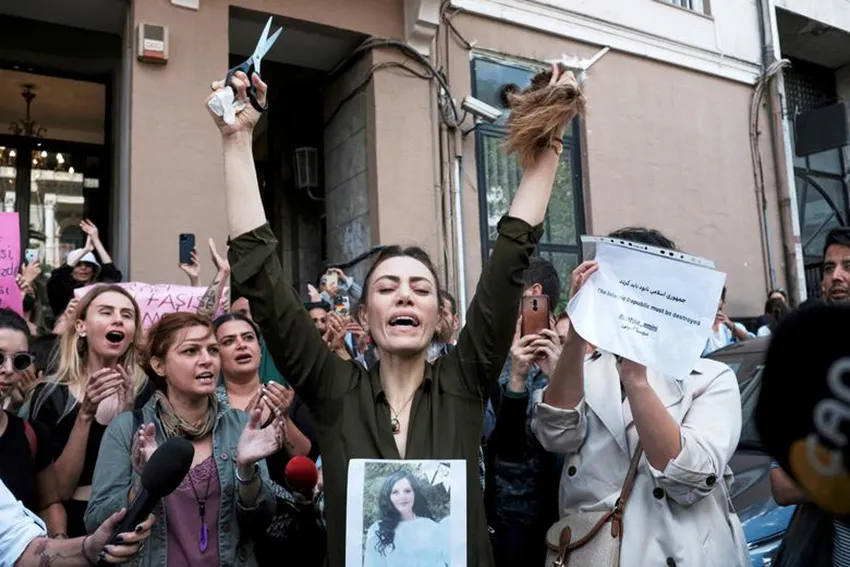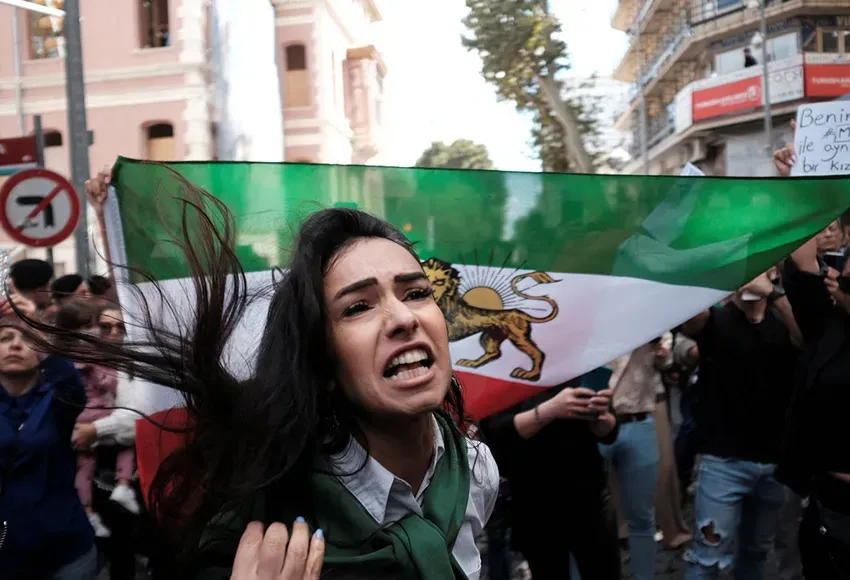In Iran, revolution is in the air, and the sparks of hope are being ignited by women. Over the last month, Iranians have taken to the streets, demanding worldwide attention as they protest their harsh theocratic-oligarchical government.
Solidarity protests have even made their way to Seattle, with demonstrators showing their support on September 30 in Westlake Center.
However, many are still unsure of just what is going on in Iran and how to support the women leading the cause. Here's some background.

What happened to Mahsa Amini?
On September 16, Mahsa Amini, a 22-year-old Kurdish-Iranian woman originally from Saqqes, in a Kurdish area in northwest Iran, died after sustaining mysterious injuries during her detention by Iran's "morality police."
The morality police are employed by the Iranian government to enforce the country's strict dress code and often stop women who are not dressed according to the modesty standards that have been in place in the country since 1981. Since the Islamic Revolution, women have been required to cover their hair in public in Iran. Failure to do so can result in detention.
On the day Amini was arrested, September 13, she was covering her hair with a headscarf. Accounts from her family and onlookers confirm that she was clothed in a long, loose black robe and a black hijab over her head.
Despite her attire, the morality police stopped her at a subway station in Tehran and took her to a detention center in an unmarked van with two other women.
Her brother followed and waited outside the center for Amini to be released. As he waited, a commotion erupted inside the center. He reported to journalists later on that within minutes, an ambulance arrived and his sister was carried out. Reports from inside the center confirm that Amini had collapsed.
The ambulance took Amini to a local hospital, where her family later found her in a coma. Three days later she died. Her family posted a photo of her before her death, and the image went viral. Iranians everywhere empathized with Amini.
New York Times reporter Farnaz Fassihi related to Amini as well, saying, "I'm Iranian American. I've lived in Iran. I've traveled in Iran, and even I have been taken to that detention center because I was showing too much hair and I was told it was too short. I had to pledge that I would never violate the hijab law ever again to be released."
Soon after her death, Iranians sought answers. Amini's family believes she was beaten by the police in the van on her way to the detention center. The other women in the van claim to have seen Amini assaulted by police and said she appeared to have sustained a major head injury.
However, Iranian government officials deny any claims of abuse. They allege that Amini must have had an underlying heart condition and collapsed in the facility due to a heart attack.
To prove their allegations, the morality police released a video of a woman they claim to be Amini grabbing her head and collapsing in the facility. The footage then cuts to medics taking the woman away.
"Nobody believes this story, they think the footage is fake," Fassihi said to The Daily.

Women-led protests
Following Amini's death, protests erupted across Iran. In 85 cities, women turned out to demonstrate by burning their hijabs and whipping their hair in the faces of the Iranian police. The movement is historic, as it is the first time that protests have been entirely led, organized, and populated by women. Amini's death may have been the spark that lit the fire, but decades of mistreatment and resentment have built up a stockpile of kindling.
Despite the mandatory hijab laws and morality police, women are the backbone of Iranian society. They work nearly all the same jobs men do, serve in politics, participate in elections, and make up more than half of all college students. However, the rights that Iranian women can enjoy are due to the hard work and activism of Iranian feminists of the '80s and '90s who protested for equality.
Now, the women of Iran want to choose whether or not they wear their hijabs, and they want the abolition of the morality police. "From the beginning of the hijab laws, women have been protesting and challenging the law. Constantly testing the limits one hair strand at a time," Fassihi said.
Activism has come at a steep cost for many women. The government classifies activists as people working against the state. Many have paid the price with jail time and exile.
Amini is now the face of the movement, but the protests are about so much more than just her death and quickly escalated beyond the original fight against state-mandated dress codes. "To me, this is a women's revolution against a gender apartheid regime," Iranian refugee, journalist, and activist Masih Alinejad told CNN about the movement.
The protesters are fighting against the mistreatment of all women at the hands of the morality police. They are fighting against the detainment and execution of LGBTQ+ people. They are fighting the theocracy of Iran, which has created an air of desperation.
Some protesters are demanding more than reform. They want the whole system toppled, starting with the Supreme Leader Ali Khamenei.
"This is not just about women's rights or reform; it's a population that says the status quo is not working. The only way forward is to topple the whole system," Fassihi explained. "The compulsory hijab is not just a small piece of cloth for Iranians. It's like the Berlin Wall. I keep saying that: If women can successfully tear this wall down, the Islamic Republic won't exist."
LGBTQ+ people in Iran
LGBTQ+ people don't live in Iran. At least, that's what the government wants people to believe. Homosexuality is a crime punishable by death.
Two LGBTQ+ Iranian women are currently paying the price as they await the death penalty. Zahra Sedighi-Hamadani and Elham Choubdar have been sentenced to death on charges of "corruption on earth," according to Amnesty.org. Legal documents state that the two were targeted due to their "real or perceived sexual orientation and/or gender identity and their social media activities in support of LGBTI communities." On September 6, they were also charged with human trafficking.
Sedigi-Hamadani was first detained by the Iraqi government in October of 2021 after a BBC documentary was released in which she spoke out about abuses facing LGBTQ+ people in Iran.
After being released from an Iraqi prison, Sedigi-Hamadani attempted to flee to Turkey to avoid persecution by the Iranian government. "If I make it, I will continue to look after LGBTQ people. I will be standing behind them and raising my voice. If I don't make it, I will have given my life for this cause," she said in a video for the Iranian Lesbian and Transgender Network in December.
Unfortunately, she was detained before making it to Turkey and has been held in solitary confinement, awaiting the death penalty, ever since.
Economic dire straits
Under Khamenei, Iranians have watched the economy collapse. Despite living in one of the richest regions of the world, the country is in a shambles, and this is a direct result of economic sanctions placed on Iran by the US government.
After the 9/11 attack, Pres. Bush believed Iran had a stockpile of uranium that could be used to make nuclear weapons and was not being transparent enough. He urged Iran to negotiate, but Khamenei would not budge. In response, Bush placed stiff economic sanctions on Iran, which effectively depleted its economy.
In 2015, the United States under Pres. Obama finally removed the sanctions after reaching an agreement with Iran. The country's economy was finally able to start recovering, but this did not last long. Just two years later, in 2017, Pres. Trump backed out of the deal and imposed the stiffest sanctions Iran had ever seen. This decimated its already unhealthy economy, tanked the national currency, and left Iranians to deal with major inflation.
Today, the average family in Iran cannot afford meat. Dairy products, like eggs, have become luxury items. People cannot even afford to flee the country. They are trapped in growing poverty and desperation. "They feel like they have nothing to lose. They are willing to take risks to get the world to hear them," Fassihi said.
Elections don't mean anything to Iranians anymore, either. The Iranian state vets all candidates before the election, so anyone the people could rally behind is often disqualified before they get a chance to garner votes.
The women of Iran are now taking on a role as revolutionary leaders. Like many 21st-century movements, there is no singular leader. This can make the revolution harder to target, but also harder to organize. However, the movement only seems to be growing, as more and more women are taking to the streets and chanting "death to dictators!"
Violence, prison, censorship
Iranian police are not going easy on protesters. Anti-riot police and militia have been seen opening fire on crowds of protesters. Videos of armed policemen beating and harassing female protesters have circulated on the web. "From the beginning, the level of the crackdown was so brutal. They opened ...on teenagers, school leaders, university students. They opened fire on unarmed people," Alinejad said.
Reports out of Iran now show that over 180 protesters have been killed by police. Of course, many believe this number to be far lower than reality. Each day, more reports are coming from families of young women who left to protest, saying that their daughters and sisters have not returned home.
Even those who protest privately, from the safety of their computer screens, are seeing serious outcomes. The writer who first broke the story of Amini's death is now being held in prison in solitary confinement.
The country is also cutting internet access to prevent video footage from going viral. "The Iranian regime cut off the internet in some cities to prevent the rest of the world from getting to know about the crackdown, to get to learn about the number of people killed," Alinejad said.
Call for solidarity
While Iranian women are taking to the internet to spread awareness of the violence they are facing and protesting for their human rights, they also want to be clear that this fight is their own. They are calling for foreign solidarity, but not interference. "Many people in the streets are now risking their lives and want an end to the regime. They aren't asking for the US government to go there and save them at all. They're brave enough to do it themselves. But they're asking the US government not to save the Iranian regime," Alienjad said.
"You cannot call yourself a feminist in the West, in America, and not take action on one of the most important feminist revolutions, in Iran. By saying that, I don't mean that I want the feminists to just appear on TV and cut their hair to show their solidarity. I want, especially the female politicians, to cut their ties... and instead take to the streets to show their solidarity with the women of Iran. When the Women's March happened here in America, like every single feminist around the world showed solidarity."
Many female politicians are showing solidarity by speaking out about the protests in Iran. "Solidarity with the courageous women and allies in Iran protesting for their freedom," wrote Rep. Alexandria Ocasio-Cortez on Twitter. "Mahsa Amini was senselessly murdered by the same patriarchal and autocratic forces repressing women the world over. The right to choose belongs to us all, from hijabs to reproductive care."
US Sen. Patty Murray also spoke out about the issue, writing, "I stand with women all across Iran protesting the death of #MahsaAmini and the ongoing human rights abuses at the hands of the Iranian government and their so-called 'morality police.'"
Regardless of harsh pushback, Iranian women are showing no signs of quitting. "Even if they crush the protests, they're unable to kill it," Fassihi said. "Women are seeing unity in a way they've never seen before. People coming together from different ages, people are leaving their front doors open for protesters to run in and take shelter. Mothers and grandmothers are making food and emergency kits for the protesters. It will be hard for the Republic to reverse this. The young women who are leading say what's happening right now can't be undone. Iran will not go back to the way it was."


